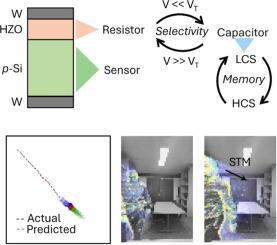一种具有铁电控制的静态、事件和短期记忆模式的神经形态光电探测器,用于片上实时时空分类和运动预测
IF 17.1
1区 材料科学
Q1 CHEMISTRY, PHYSICAL
引用次数: 0
摘要
基于事件的视觉传感器为基于帧的成像提供了稀疏、低延迟的替代方案,但它们缺乏嵌入式内存和静态场景感知限制了在智能系统中的应用。大多数设计只捕捉瞬态变化,并依赖外部处理器进行分类和运动预测,缺乏实时、上下文感知决策所需的时间连续性和能源效率。在这里,我们报道了一种神经形态光电探测器,它集成了电压控制的静态传感、事件检测和可调短期记忆(STM)在单个像素内。通过将光敏硅层与铁电HfZrO2堆叠相结合,该器件可以在自供电事件尖峰(~73 µs)、稳态光电流和可编程stm类衰减响应之间实现偏置相关的转换。通过将传感器阵列与执行片上学习和推理的现场可编程门阵列耦合,该系统本质上对实时时间动态进行编码,从而直接对时空模式(如手势、逻辑序列和莫尔斯电码)进行分类,准确率超过93%,同时还能实现动态物体的实时运动预测。与基于软件的神经网络的传统事件传感器相比,由此产生的架构将功耗降低了1000倍以上,将推理速度提高了200倍以上,而STM将动态位置跟踪任务的预测精度从20%提高到80%以上。这种统一的传感器处理器平台为紧凑、自适应和低功耗的神经形态视觉系统提供了可扩展的途径。本文章由计算机程序翻译,如有差异,请以英文原文为准。

A neuromorphic photodetector with ferroelectric-controlled static, event, and short-term memory modes for on-chip real-time spatiotemporal classification and motion prediction
Event-based vision sensors offer sparse, low-latency alternatives to frame-based imaging, but their lack of embedded memory and static scene awareness limits use in intelligent systems. Most designs capture only transient changes and rely on external processors for classification and motion prediction, lacking the temporal continuity and energy efficiency needed for real-time, context-aware decision-making. Here, we report a neuromorphic photodetector that integrates voltage-controlled static sensing, event detection, and tunable short-term memory (STM) within a single pixel. By combining a photoactive silicon layer with a ferroelectric HfZrO2 stack, the device enables bias-dependent transitions between self-powered event spikes (∼73 µs), steady-state photocurrent, and programmable STM-like decay responses. By coupling the sensor array to a field-programmable gate array that performs on-chip learning and inference, the system intrinsically encodes real-time temporal dynamics to directly classify spatiotemporal patterns—such as gestures, logic sequences, and Morse code—with over 93 % accuracy, while also enabling real-time motion prediction of dynamic objects. The resulting architecture reduces power consumption by over 1000 × and boosts inference speed by more than 200 × compared to conventional event sensors with software-based neural networks, while STM elevates prediction accuracy from 20 % to over 80 % in dynamic position tracking tasks. This unified sensor–processor platform offers a scalable route toward compact, adaptive, and low-power neuromorphic vision systems.
求助全文
通过发布文献求助,成功后即可免费获取论文全文。
去求助
来源期刊

Nano Energy
CHEMISTRY, PHYSICAL-NANOSCIENCE & NANOTECHNOLOGY
CiteScore
30.30
自引率
7.40%
发文量
1207
审稿时长
23 days
期刊介绍:
Nano Energy is a multidisciplinary, rapid-publication forum of original peer-reviewed contributions on the science and engineering of nanomaterials and nanodevices used in all forms of energy harvesting, conversion, storage, utilization and policy. Through its mixture of articles, reviews, communications, research news, and information on key developments, Nano Energy provides a comprehensive coverage of this exciting and dynamic field which joins nanoscience and nanotechnology with energy science. The journal is relevant to all those who are interested in nanomaterials solutions to the energy problem.
Nano Energy publishes original experimental and theoretical research on all aspects of energy-related research which utilizes nanomaterials and nanotechnology. Manuscripts of four types are considered: review articles which inform readers of the latest research and advances in energy science; rapid communications which feature exciting research breakthroughs in the field; full-length articles which report comprehensive research developments; and news and opinions which comment on topical issues or express views on the developments in related fields.
 求助内容:
求助内容: 应助结果提醒方式:
应助结果提醒方式:


